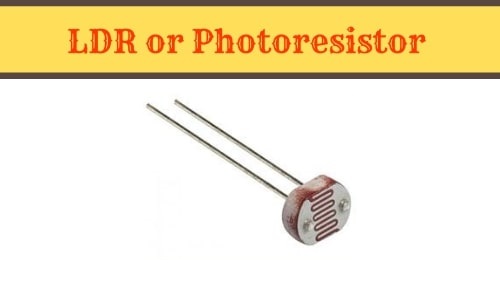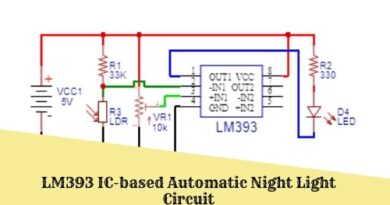LDR (Light Dependent Resistor) or Photoresistor
Hello friends! Welcome back to ElectroDuino. This blog is based on the LDR(Light Dependent Resistor) or Photoresistor. Here we will discuss what is LDR, its full form, Pin Configuration, Symbol, Working Principle, Specification, and Applications.
What is LDR or Photoresistor
LDR or Photoresistor is a type of variable resistor, its resistance varies according to the change in the intensity of light falling on its surface. LDR’s full form is Light Decreasing Resistance. It is also known as a photoresistor photoconductive cells or simply photocells.
The Light Dependent Resistor or Photoresistor works on the principle of “Photoconductivity”. Basically, when light falls on the surface of LDR, its resistance decreases, and the conductivity of the material increases. When no light falls on the surface of the LDR, its resistance increases, and the conductivity of the material decreases.
Pin Configuration/Pinout of Light Decreasing Resistance or Photoresistor
LDR Consists of two terminals. The first question that comes to the minds of beginners about LDR polarity like other two-terminal components, but it has no polarity like a simple resistor. it means these can be connected in any direction in a circuit.

LDR symbol
You will see different types of symbols used in different circuits. The LDR symbol is just as similar to the Resistor symbol, but it has inward arrows, which is made different from the resistor symbol. The arrows indicate the light signals. the different types of symbols are shown below

Types of LDR or Photoresistor
Photoresistor or LDR is categorized into two types based on the materials used to construct them. These are Intrinsic photoresistors and Extrinsic photoresistors
Intrinsic photoresistors
The intrinsic photoresistor is made of un-doped pure semiconductor materials such as silicon or germanium. When Photons fall on the LDR then the semiconductor material’s excited electrons move from the valence band to the conduction band and the number of charge carriers are increased. So, material conductivity will be increase and resistance will be decreased.
Extrinsic photoresistors
The Extrinsic photoresistor is made of semiconductor of materials doped with impurities. These impurities create a new energy band above the existing valence band which is filled with electrons. As a result, this reduces the bandgap. So, less amount of energy is required to excite the electrons to move it to the conduction band. Extrinsic photo resistors are mainly used for long wavelengths.
LDR Working Principle
The Light Dependent Resistor or Photoresistor works on the principle of “Photoconductivity”. Photoconductivity is an optical phenomenon, when the material absorbed light then the material’s conductivity is increased.

It is made of semiconductor material that has high resistance. It has a high resistance because there are very few electrons that are free and these free electrons can able move by external energy.
When light falls or photons fall on the semiconductor material, the electrons in the valence band of the semiconductor material are excited to the conduction band. When light intensity increases i.e There are more photons, so, the energy will increase. Then, the bandgap of the semiconductor material to make the electrons jump from the valence band to the conduction band. So the material conductivity increase and resistance decrease.

LDR resistance and conductivity depend on the light. When light intensity increases on the LDR surface, then its resistance decreases, and conductivity increases. When light intensity decreases on its surface, then its resistance increases and conductivity decreases. In the dark, its resistance is maximum and conductivity is low.
Specification
Here we will discuss the most commonly used 5mm LDR specifications.
- Model:5528
- Operating Temperature: -30 ~ +70 deg C
- Head Dia: 5mm
- Maximum Voltage: 150 Volt DC
- Maximum Wattage: 100mW
- Light Resistance (10 Lux): 10-20 Kohm
- Dark Resistance: 2 Mohm
- Response time: 20ms (Rise), 30ms (Down)
Applications
- Day or Night detection
- Detect light and dark
- Automatic Light on/off circuit.





